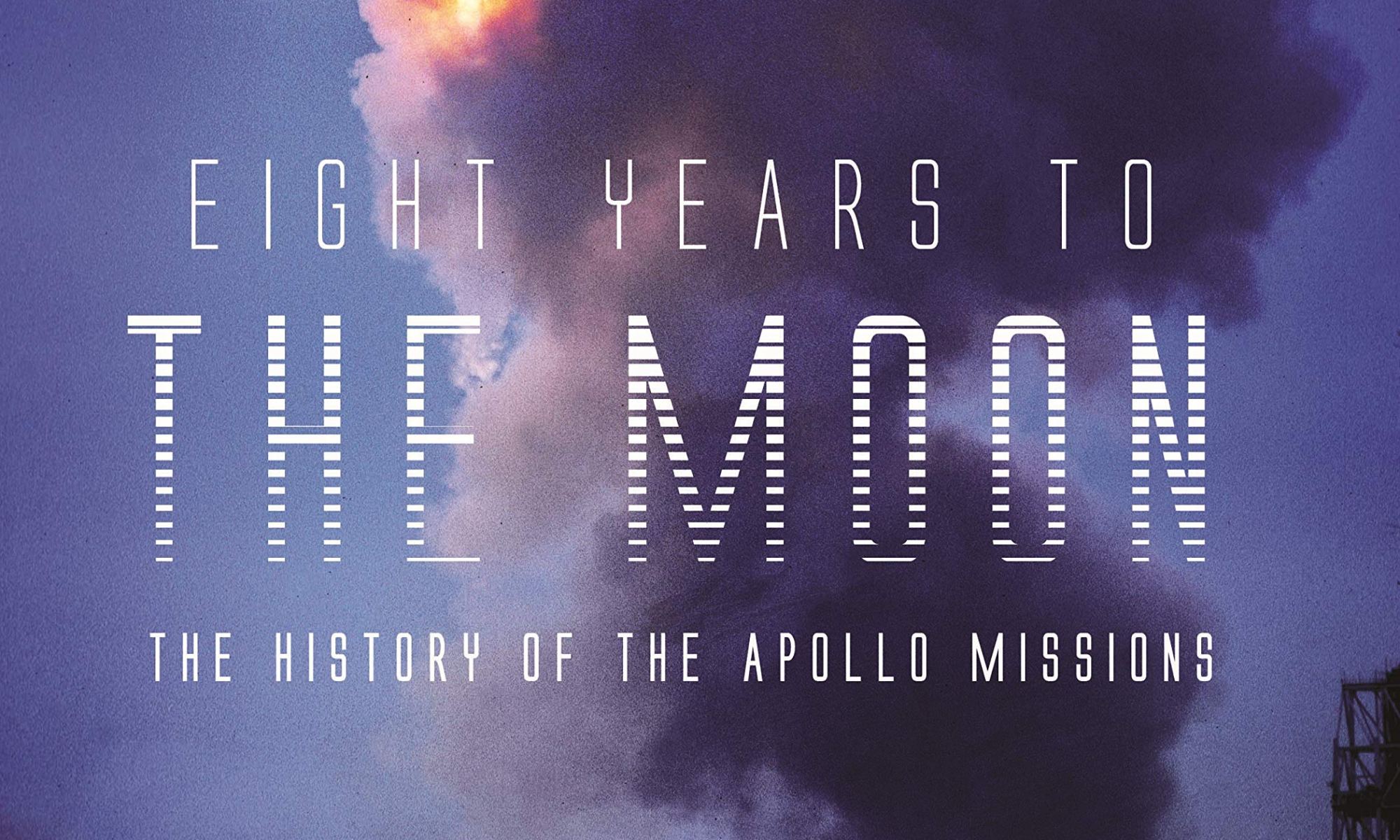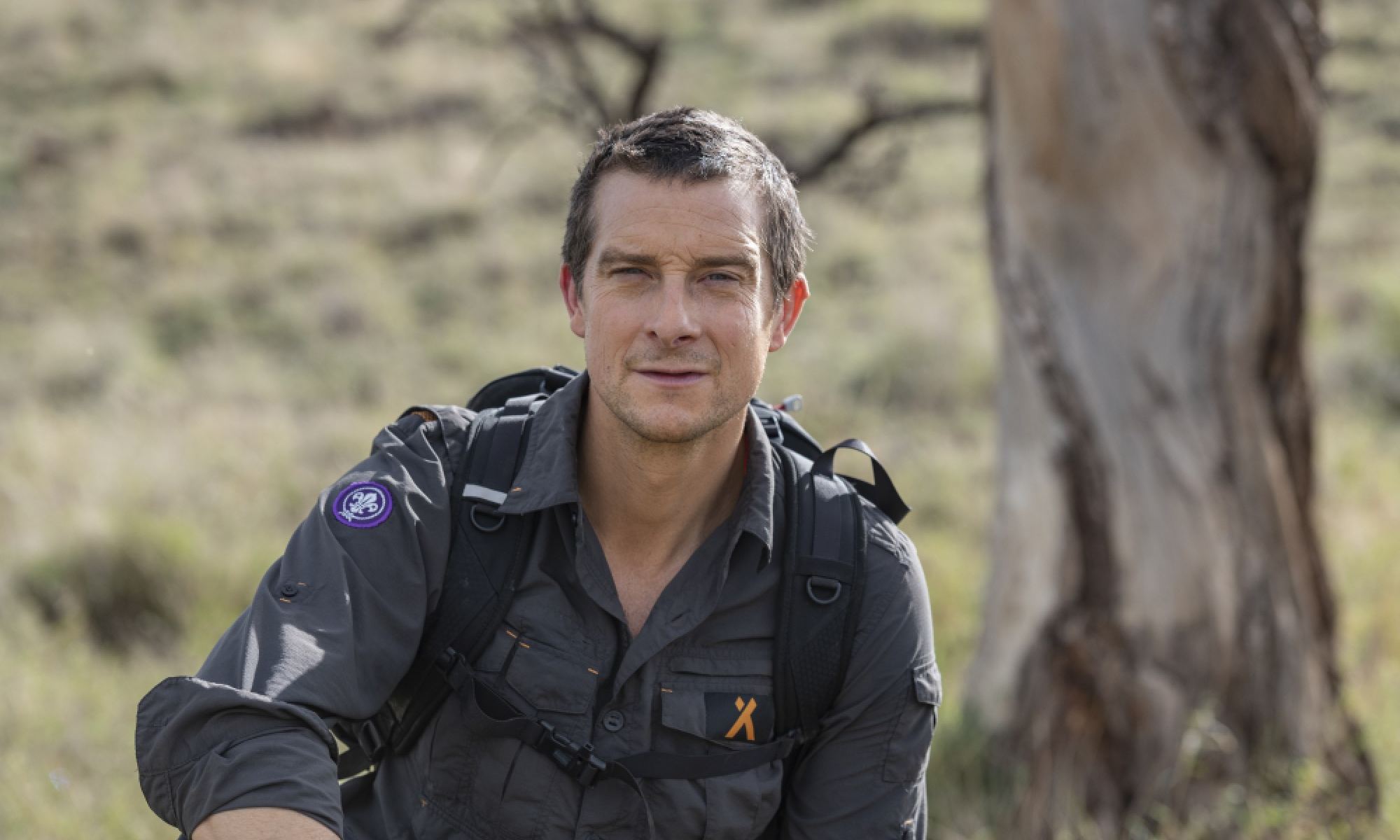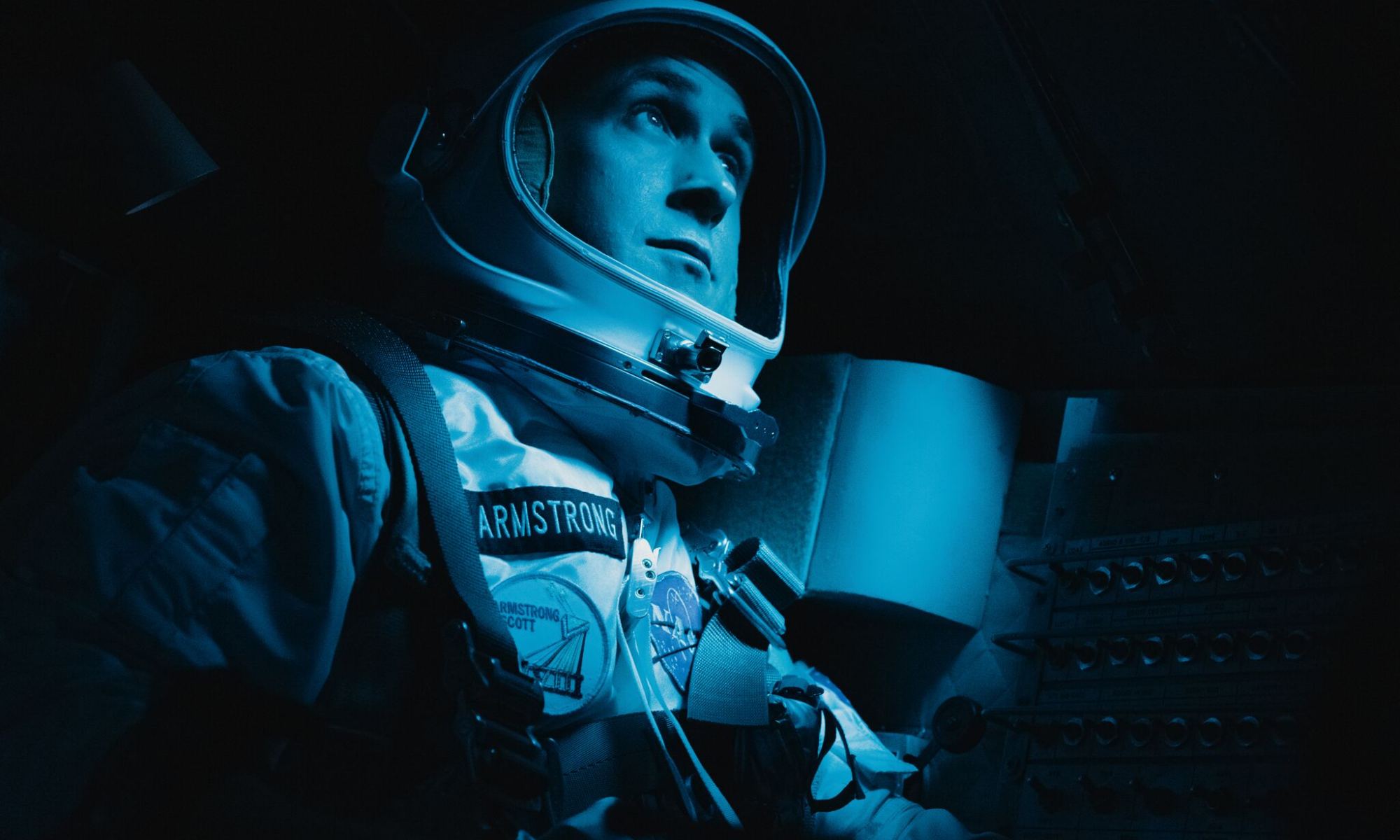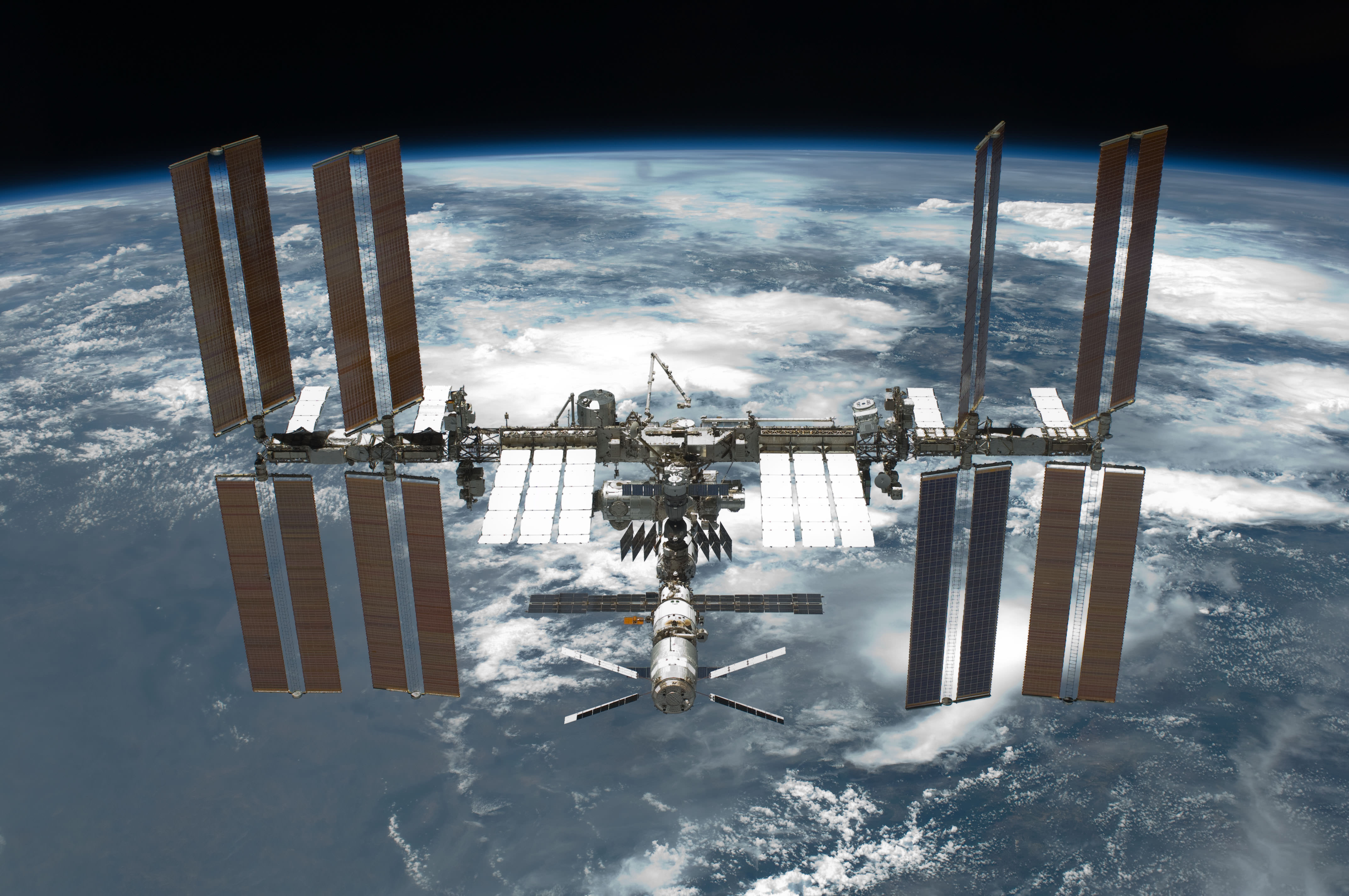Editor’s note: “Eight Years to the Moon: The History of the Apollo Missions” is a new book, just out today, written by Universe Today’s Nancy Atkinson, with a foreword by Apollo 9 astronaut Rusty Schweickart. The book tells the unique personal stories of over 60 engineers and scientists who worked behind the scenes to make the Apollo program
Climate Change Q & A with Bear Grylls
Bear Grylls isn’t a climate scientist, but in his travels around the world as an adventurer, survivalist and host of numerous nature shows, he has witnessed firsthand our planet’s changing climate.
This is especially true in a new series Grylls hosts and narrates on the National Geographic channel called “Hostile Planet.” While the show does not focus on climate change per se, it doesn’t shy away from portraying how our world is rapidly changing and how those changes affect various animal species.
Continue reading “Climate Change Q & A with Bear Grylls”What Neil Armstrong’s Sons Really Think About the Movie “First Man”
Like millions of other people around the world, on July 20, 1969, Rick and Mark Armstrong watched Apollo 11’s Moon landing on the television set in their living room. But for those two boys – aged 12 and 6 at the time – it was their Dad who was taking humanity’s first steps on another world 49 years ago.
And now that new generations will be able to experience Neil Armstrong’s historic steps through the new movie First Man, the Armstrong boys are extremely happy and pleased that people will get to know their father as they know and remember him, instead of the way he has been characterized over the years.
Continue reading “What Neil Armstrong’s Sons Really Think About the Movie “First Man””
What is the Perfect Gift for Every Space Enthusiast? The Year in Space Calendar 2018!
What is the most wonderful time of the year? In my opinion, it is when the new Year In Space Calendars come out! This is our most-recommended holiday gift every year and whether it’s the gigantic wall calendar or the spiral-bound desk calendar, the 2018 versions don’t disappoint. They are full of wonderful color images, daily space facts, and historical references. These calendars even show you where you can look in the sky for all the best astronomical sights.
These calendars are the perfect gift every space enthusiast will enjoy all year.
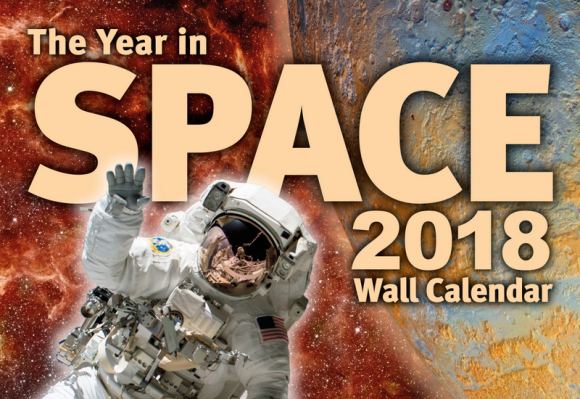
The gorgeous wall calendar has over 120 crisp color images and is larger, more lavishly illustrated, and packed with more information than any other space-themed wall calendar. It’s a huge 16 x 22 inches when hanging up.
The Year In Space calendars take you on a year-long guided tour of the Universe, providing in-depth info on human space flight, planetary exploration, and deep sky wonders. You’ll even see Universe Today featured in these calendars 🙂
The Year in Space calendars normally sell for $19.95, but Universe Today readers can buy the calendar for only $14.95 or less, with additional discounts that appear during checkout if you buy more than 1 copy at a time. Check out all the details here.
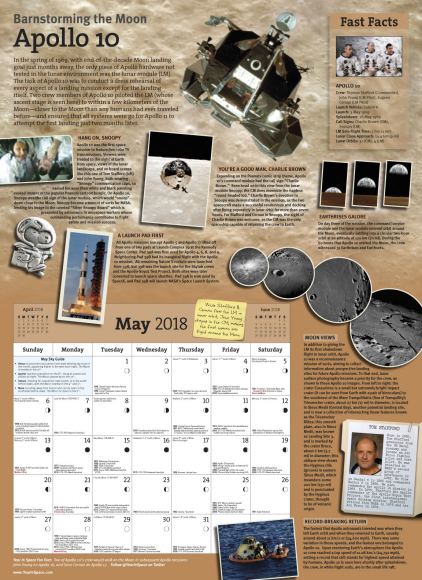
Other features of the Year In Space calendar:
– Background info and fun facts
– A sky summary of where to find naked-eye planets
– Space history dates
– Major holidays (U.S. and Canada)
– Daily Moon phases
– A mini-biography of famous astronomer, scientist, or astronaut each month
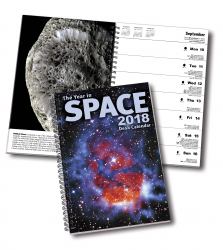
The 136-Page Desk Calendar is available at a similar discounts. The desk calendar also includes a Monthly Sky Summary, which is a handy month-by-month list of what’s visible in the night sky, such as conjunctions, meteor showers, eclipses, planet visibility, and more. Plus there’s information on planetary exploration, including a comprehensive look at what to expect from the many planetary missions taking place in the year ahead.
Preview the calendars on the Year In Space website, where you can also get a direct link to Amazon. Because all shipping is handled through Amazon this year, currently calendars can only ship to US addresses.
I Still ♥ the ISS: More Reasons to Love the International Space Station
Back in 2008, I professed my feelings, bared my soul and told all about how I absolutely was in love the International Space Station. Nine and a half years ago when I wrote that article, titled “I ‘Heart’ the ISS: Ten Reasons to Love the International Space Station,” the ISS was still under construction, only three astronauts/cosmonauts at a time could live on board, and scientific research was sparse. Some people routinely questioned the cost and utility of what some people called an expensive erector set or orbiting white elephant.
Continue reading “I Still ♥ the ISS: More Reasons to Love the International Space Station”
First Cosmic Event Observed in Both Gravitational Waves and Light

About 130 million years ago, in a galaxy far away, two neutron stars collided. The cataclysmic crash produced gravitational waves, ripples in the fabric of space and time. This event is now the 5th observation of gravitational waves by the Laser Interferometer Gravitational wave Observatory (LIGO) and Virgo collaboration, and the first detected that was not caused by the collision of two black holes.
But this event — called a kilonova — produced something else too: light, across multiple wavelengths.
Continue reading “First Cosmic Event Observed in Both Gravitational Waves and Light”
Watch a House-Sized Asteroid Pass Close to Earth Tonight (October 11/12)

On Oct. 12, a house-size asteroid will pass quite close to Earth – only 26,000 miles (42,000 kilometers) away. This is just above the orbital altitude of communications satellites and a little over one-tenth the distance to the Moon. But not to fear, it has no chance of hitting Earth.

Asteroid 2012 TC4 was discovered almost 4 years ago to the day, on October 4, 2012, just a week before it made another close pass by Earth.
With a little more advance notice this time around, NASA and asteroid trackers around the world are using the close pass to test their ability to operate as a coordinated International Asteroid Warning Network. This is a growing global observing network to communicate and coordinate their optical and radar observations in a real scenario.
“Asteroid trackers are using this flyby to test the worldwide asteroid detection and tracking network, assessing our capability to work together in response to finding a potential real asteroid-impact threat,” said Michael Kelley, program scientist and NASA lead for the TC4 observation campaign. You can read more details about the observing campaign in our previous article.
You can watch it pass by too, if you have a at least an 8 inch telescope, according to our David Dickinson, who has a very informative post about 2012 TC4 at Sky & Telescope.
Closest approach will be at on October 12, 2017, at 5:41 Universal Time (1:41 a.m. EDT).
You can also watch a couple of webcasts of the pass:
Virtual Telescope will have a live feed, and the Slooh Telescope crew will also host a live feed starting tonight at 8 pm EDT on Oct. 11.
2012 TC4 is estimated to be 45 to 100 feet (15 to 30 meters) in size.
NASA’s Asteroid Watch says that no asteroid currently known is predicted to impact Earth for at least the next 100 years.
Dwarf Planet Haumea Has a Ring
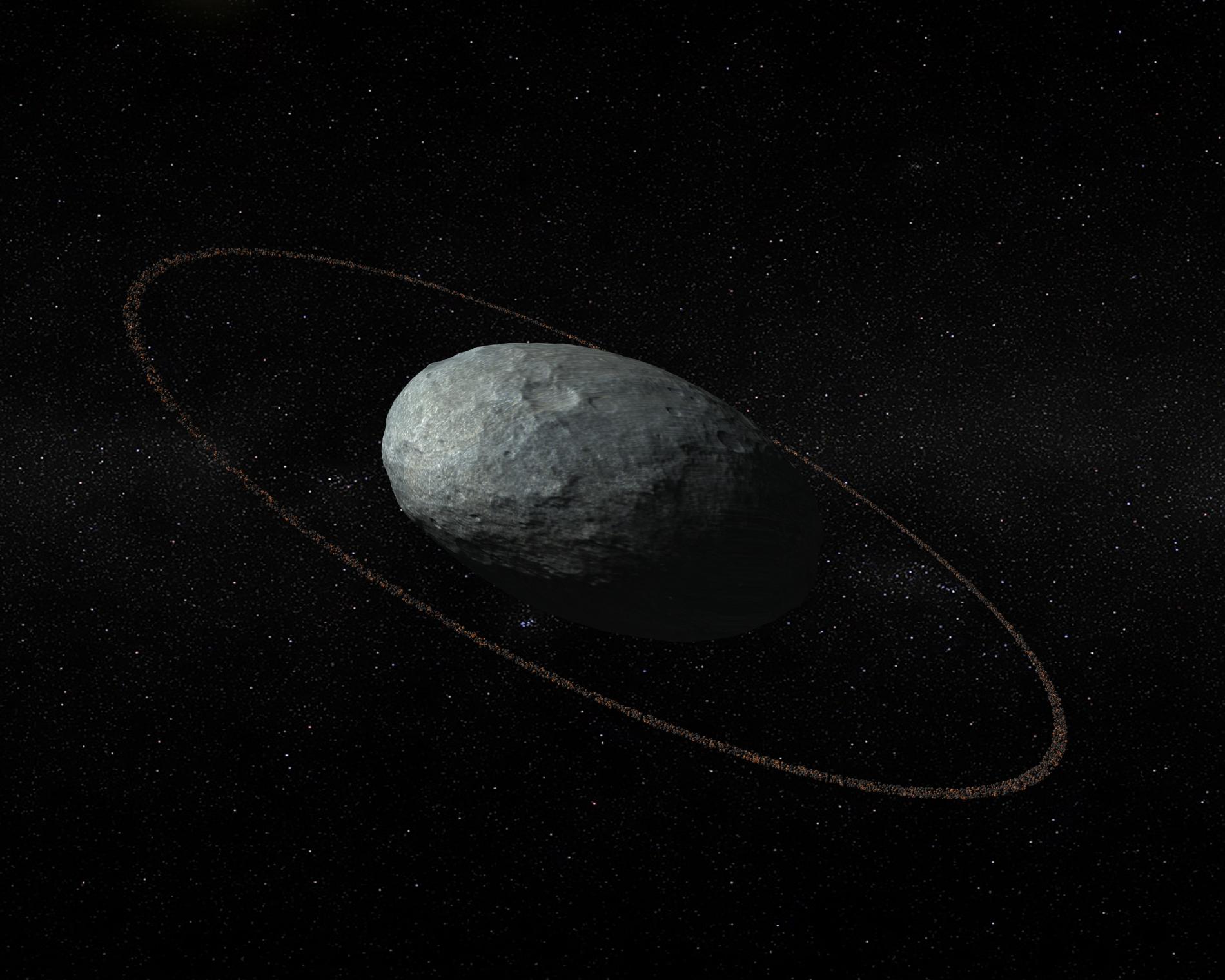
A unique opportunity to study the dwarf planet Haumea has led to an intriguing discovery: Haumea is surrounded by a ring.
Add this to the already long list of unique things about the weird-shaped world with a dizzying rotation and a controversial discovery.
On January 21, 2017 Haumea passed in front of a distant star, in an event known as an occultation. The background star can – pardon the pun – shine a light on the object passing in front, providing information about a distant object — such as size, shape, and density — that is otherwise difficult to obtain. Since an occultation with Haumea had never been observed before, scientists were first eager, and then surprised.
“One of the most interesting and unexpected findings was the discovery of a ring around Haumea,” said said Pablo Santos-Sanz, from the Institute of Astrophysics of Andalusia (IAA-CSIC) in a statement.
This is the first time a ring has been discovered around a trans-neptunian object, and the team said this discovery shows that the presence of rings could be much more common than was previously thought, in our Solar System as well as in other planetary systems.
“Twelve telescopes from ten different European observatories converged on the phenomenon,” said José Luis Ortiz, who led the observational effort, and is also from IAA-CSIC. “This deployment of technical means allowed us to reconstruct with a very high precision the shape and size of dwarf planet Haumea, and discover to our surprise that it is considerably bigger and less reflecting than was previously believed. It is also much less dense than previously thought, which answered questions that had been pending about the object.”
The team said their data shows that the egg-shaped Haumea measures 2,320 kilometers in its largest axis. Previous estimates from various observations put the size at roughly 1,400 km. It takes 3.9 hours for Haumea rotate around its axis, much less than any other body in the Solar System that measures more than a hundred kilometers long. This rotational speed likely caused Haumea to flatten out, giving it an ellipsoid shape. It orbits the Sun in an elliptical loop that takes 284 years to complete. Additionally Haumea has two small moons.
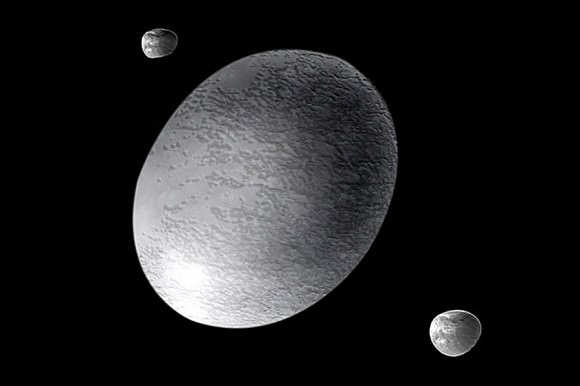
Ortiz and team say their data shows the newly discovered ring lies on the equatorial plane of the dwarf planet, and it “displays a 3:1 resonance with respect to the rotation of Haumea, which means that the frozen particles which compose the ring rotate three times slower around the planet than it rotates around its own axis.”
Ortiz says there might be a few possible explanations for the formation of the ring; it may have originated in a collision with another object, or in the dispersal of surface material due to the planet’s high rotational speed.
Of course, other objects in our Solar System have rings: all the giant planets have rings, with Saturn’s being the most massive and well know. But small centaur asteroids located between Jupiter and Neptune were found to have rings, too.
“Now we have discovered that bodies even farther away than the centaurs, bigger and with very different general characteristics, can also have rings,” said Santos-Sanz.
You may recall there was great controversy over the discovery of Haumea. The discovery was originally announced in 2005 by Mike Brown from Caltech, along with his colleagues Chad Trujillo of the Gemini Observatory in Mauna Kea, Hawaii, and David Rabinowitz, of Yale University.
But then Ortiz and Santos-Sanz attempted to scoop Brown et. al by sending in their claim to discovery to the Minor Planet Center before Brown’s paper was published. It was later learned that Ortiz and colleagues had accessed the Caltech observing logs remotely, looking at when and where Brown was looking with his telescopes. Ortiz and team initially denied the claims, but later conceded accessing the observation logs, maintaining they were just verifying whether they had discovered a new object in observations from 2003.
I asked Brown today if anything was ever officially resolved about the controversy.
“I think the resolution is that it is generally accepted that they stole our positions, but no one wants to think about it anymore,” he said via email.
But the discovery of a ring Haumea, Brown said, looks solid.
“I will admit to being wary of anything Ortiz says, so I checked the data very carefully,” Brown said. “Even I have to agree that the detection looks pretty solid. Haumea is weird, so it’s less surprising than, say, finding rings around something like Makemake. But, still, this was not something I was expecting!”
Hey Citizen Scientists! Help NASA Analyze Images Taken from the Space Station
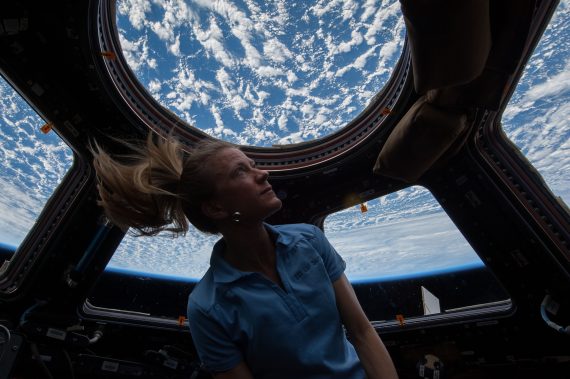
Calling all citizen scientists, geography buffs, fans of the International Space Station and those who love that orbital perspective!
CosmoQuest has a brand new project in coordination with NASA and the Astronomical Society of the Pacific (ASP) where you can help identify features in photographs taken by astronauts from the space station.
The project is called Image Detective. I’ve tried it out, and wow, THIS is a lot of fun!
Now, I absolutely love seeing the images taken of Earth from the ISS, and I routinely follow all the astronauts on board on social media so I can see their latest images. And I also love the concept of regular, everyday people doing science. Plus I’m a big fan of CosmoQuest and their ‘quest’ to bring science to the public.
But still, the setup CosmoQuest has is really great and the process is easy. Citizen scientists are asked to help identify geographic features (natural or human-made) and then determine the location on Earth where the photo is centered.
I found that last part to be the most difficult, but I’ve been known to have trouble reading a map … so I’m hoping that I can improve a bit with more practice.
Public Invited to Test New Tool to Study Earth using Photos Taken by International Space Station Astronauts https://t.co/zKuSbwTvZx pic.twitter.com/JslJU6DIxo
— Cosmo Quest (@cosmoquestX) September 28, 2017
“The astronauts’ photos of Earth are visually stunning, but more than that, they can be used to study our changing Earth,” said our good friend Dr. Pamela Gay, who is the Director of Technology and Citizen Science at ASP. “From erupting volcanoes, to seasonal flooding, these images document the gradual changes that happen to our landscape. The trick is, we need to make these images searchable, and that means taking the time to sort through, analyze, and label (add metadata) the unidentified images within the database of 1.5 million plus photos.”
You can try it out here: http://cosmoquest.org/ImageDetective.
The team says that Image Detective spreads the significant work necessary to label all of the images out to citizen scientists across the world.
“This is a unique, powerful, and beautiful image data set that has already yielded excellent research science. But the data set needs the many eyes and minds of citizen scientists to reach its full potential as a publicly available, searchable catalog,” said Dr. Jennifer Grier, a Senior Scientist and Senior Education and Communication Specialist at Planetary Science Institute (PSI) and CosmoQuest’s lead support scientist. “With the additions that citizen scientists as detectives can make, professional research scientists will be able to conduct more research into our changing world, and do so much more effectively.”
Rosetta Team Finds New, Final Image Hiding in the Data

ESA scientists have found one additional image from the Rosetta spacecraft hiding in the telemetry. This new image was found in the last bits of data sent by Rosetta immediately before it shut down on the surface of Comet 67P/Churyumov–Gerasimenko last year.
The new image shows a close-up shot of the rocky, pebbly surface of the comet, and looks somewhat reminiscent of the views the Huygens lander took of the surface of Saturn’s moon Titan.

Planetary astronomer Andy Rivkin noted on Twitter that for size context, he estimates the block just right of center looks to be about the size of a hat. That’s a fun comparison to have (not to mention thinking about hats on Comet 67P!)
The picture has a scale of 2 mm/pixel and measures about 1 m across. It’s a really ‘close’ close-up of Comet 67P.
“The last complete image transmitted from Rosetta was the final one that we saw arriving back on Earth in one piece moments before the touchdown at Sais,” said Holger Sierks, principal investigator for the OSIRIS camera at the Max Planck Institute for Solar System Research in Göttingen, Germany. “Later, we found a few telemetry packets on our server and thought, wow, that could be another image.”
The team explains that the image data were put into telemetry ‘packets’ aboard Rosetta before they were transmitted to Earth, and the final images were split into six packets. However, for the very last image, the transmission was interrupted after only three full packets. The incomplete data was not recognized as an image by the automatic processing software, but later, the engineers in Göttingen could make sense of these data fragments to reconstruct the image.
You’ll notice it is rather blurry. The OSIRIS camera team says this image only has about 53% of the full data and “therefore represents an image with an effective compression ratio of 1:38 compared to the anticipated compression ratio of 1:20, meaning some of the finer detail was lost.”
That is, it gets a lot blurrier as you zoom in compared with a full-quality image. They compared it to compressing an image to send via email, versus an uncompressed version that you would print out and hang on your wall.
Rosetta’s final resting spot is in a region of active pits in the Ma’at region on the two-lobed, duck-shaped comet.
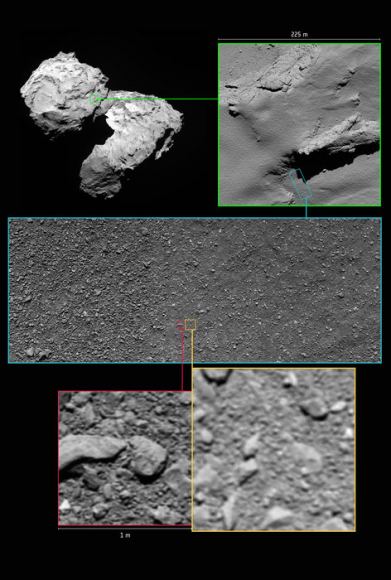
Launched in 2004, Rosetta traveled nearly 8 billion kilometers and its journey included three Earth flybys and one at Mars, and two asteroid encounters. It arrived at the comet in August 2014 after being in hibernation for 31 months.
After becoming the first spacecraft to orbit a comet, it deployed the Philae lander in November 2014. Philae sent back data for a few days before succumbing to a power loss after it unfortunately landed in a crevice and its solar panels couldn’t receive sunlight.
But Rosetta showed us unprecedented views of Comet 67P and monitored the comet’s evolution as it made its closest approach and then moved away from the Sun. However, Rosetta and the comet moved too far away from the Sun for the spacecraft to receive enough power to continue operations, so the mission plan was to set the spacecraft down on the comet’s surface.
And scientists have continued to sift through the data, and this new image was found. Who knows what else they’ll find, hiding the data?

